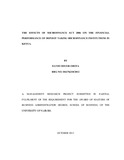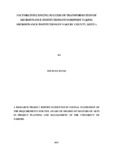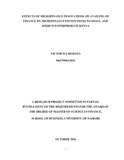| dc.contributor.author | Obota, David O | |
| dc.date.accessioned | 2013-11-12T07:43:24Z | |
| dc.date.available | 2013-11-12T07:43:24Z | |
| dc.date.issued | 2013 | |
| dc.identifier.citation | Master Of Business Administration | en |
| dc.identifier.uri | http://erepository.uonbi.ac.ke:8080/xmlui/handle/123456789/58600 | |
| dc.description.abstract | This paper analyses the effects of regulatory and supervisory framework on the financial performance of microfinance institutions in Kenya. It starts by considering literature on both regulation and financial performance. The paper describes the Microfinance Act
2006 that came to effect in 2008 thus creating three tiers of microfinance institutions: prudentially regulated deposit-taking institutions credit only and unregulated informal groups. Those undertaking deposit-taking business were required by this regulation to transform their operations to comply with the requirements.
The main objective was to establish the effects of regulatory and supervisory framework on the financial performance of deposit taking microfinance institutions in Kenya. A descriptive survey was used with a population of all the nine DTMs licensed by Central Bank of Kenya sampled for the study. Data was analysed using ratio analysis and t – distribution analysis.
Since the study was a survey and the number in the population was not so large, all the 9
DTMs operating in Kenya were selected for the study. This study was facilitated by the use of secondary data. The financial reports from the deposit taking microfinance institutions was analysed using ratio analysis and t-distribution to establish the effects of the Microfinance Act 2006 on the financial performance of deposit taking microfinance institutions.
The study specific objective was to find out whether there was any effect of the Micro finance Act 2006 on the financial performance of deposit taking micro finance
institutions in Kenya. The analysis was done through descriptive design using the T-test and mean.
According to the comparison of the performance of the DTM institutions before and after transformation the results in the study reveal no significant difference in their performance using the PEARL ratios. The ratio analysis did not meet the set benchmarks for financial performance according to the WOCCU set goals. The researcher found out that the Microfinance Act 2006 did not have any effect on the financial performance of the transformed DTMs in Kenya.
Comparing the performance of the micro finance institutions that transformed and those that didn’t, it’s evident that there was a significant difference in their performance. The transformed DTMs had higher mean in the following ratios; Return on Equity, Portfolio at Risk, Debt/ Equity ratio, operating expenses and portfolio yield. This means that the performance of the transformed DTMs was better compared to that of those MFIs that did not transform. | en |
| dc.language.iso | en | en |
| dc.publisher | University of Nairobi | en |
| dc.subject | Deposit taking, Microfinance, Microfinance Regulation, Microfinance Act 2006, financial performance. | en |
| dc.title | The Effects of Microfinance Act 2006 on the Financial Performance of Deposit Taking Microfinance Institutions in Kenya | en |
| dc.type | Thesis | en |
| local.publisher | School of Business | en |




